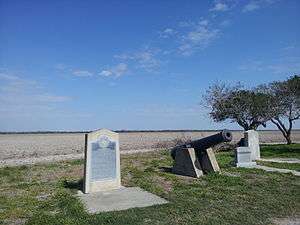Thornton Affair
| Thornton Ambush | |||||||
|---|---|---|---|---|---|---|---|
| Part of the Mexican–American War | |||||||
 Rancho de Carricitos | |||||||
| |||||||
| Belligerents | |||||||
|
|
| ||||||
| Commanders and leaders | |||||||
|
| |||||||
| Strength | |||||||
| 80 cavalry[1]:48 | 1600 cavalry, sappers, light infantry[1]:48 | ||||||
| Casualties and losses | |||||||
|
11 killed 6 wounded 49 captured[1]:48 | unknown | ||||||
The Thornton Affair, also known as the Thornton Skirmish, Thornton's Defeat, or Rancho Carricitos was a battle in 1846 between the military forces of the United States and Mexico twenty miles west upriver from Zachary Taylor's camp along the Rio Grande.[1]:48 The much larger Mexican force defeated the Americans in the opening of hostilities, and was the primary justification for U.S. President James K. Polk's call to Congress to declare war.[1]:48
Background
Although the United States had annexed Texas, both the US and Mexico claimed the area between the Nueces River and the Rio Grande.[1]:11 Polk had ordered Taylor's Army of Occupation to the Rio Grande early in 1846 soon after Mexican President Mariano Paredes declared in his inaugural address to uphold the integrity of Mexican territory to the Sabine River.[1]:26
Mariano Arista assumed command of the Division of the North on 4 April and arrived at Matamoros on 24 April, making the total force there about 5000 men, and notified Taylor hostilities had commenced.[1]:47 Arista promptly ordered General Anastasio Torrejon to cross the Rio Grande fourteen miles upstream at La Palangana.[1]:48
Battle
Taylor received two reports on 24 April of Mexicans crossing the Rio Grande, the first crossing below his camp, the other a crossing upriver.[1]:48 Taylor ordered Captain Croghan Ker to investigate downriver and Captain Seth B. Thornton with two Dragoon companies to investigate upriver.[1]:48 Ker found nothing but Thornton rode into an ambush and his 80-man force was quickly overwhelmed by Torrejon's 1600, resulting in the capture of those not immediately killed.[1]:48 Thornton's guide brought news of the hostilities to Taylor and was followed by a cart from Torrejon containing the six wounded, Torrejon stating he could not care for them.[1]:48
Aftermath
In the fierce encounter, 11 of Thornton's men were killed and 6 wounded, while the rest were taken prisoner (including Captain Thornton and his second in command Captain William J. Hardee).[1]:48 Mexican casualties are unknown. Torrejon continued on to the Matamoros-Point Isabel road, surprising Samuel H. Walker's Texas Rangers on 28 April, before continuing on to Longoreno to cover the crossing of the main Mexican army.[1]:48
Following the Battle of Palo Alto and the Battle of Resaca de la Palma, Arista and Taylor agreed to a prisoner exchange which resulted in the release of Thornton, Hardee and their men.[1]:81 Thornton was later killed in an engagement outside Mexico City.[1]:291
Declaration of War
Upon learning of the incident, President Polk asked for a Declaration of War before a joint session of the United States Congress, and summed up his justification for war by famously stating:
- "The cup of forbearance had been exhausted even before the recent information from the frontier of the Del Norte [Rio Grande]. But now, after reiterated menaces, Mexico has passed the boundary of the United States, has invaded our territory and shed American blood upon the American soil. She has proclaimed that hostilities have commenced, and that the two nations are now at war.".
On May 13, 1846, Congress declared war on Mexico, despite the Mexican government's position that Thornton had crossed the border into Mexican Texas, which Mexico maintained began south of the Nueces River (the historical border of the province of Texas). Opposition also existed in the United States, with one senator declaring that the affair had been "as much an act of aggression on our part as is a man's pointing a pistol at another's breast".[2] The ensuing Mexican–American War was waged from 1846 to 1848 with the loss of many thousands of lives and the loss to Mexico of all of its northern provinces. The Treaty of Guadalupe Hidalgo ended the war on February 2, 1848, and established the Rio Grande as the border between Texas and Mexico, and led to Mexico recognising Texas as a part of the United States.
See also
References
External links
- History channel "The Mexican-American War"
- Battle report and list of casualties
- A Continent Divided: The U.S.-Mexico War, Center for Greater Southwestern Studies, the University of Texas at Arlington